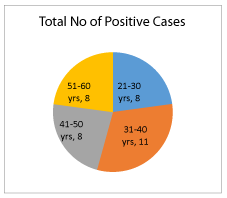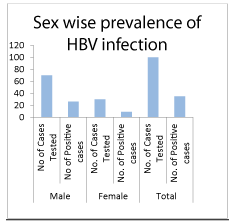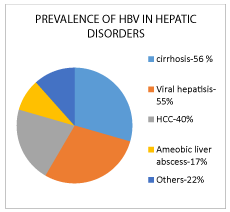A Study on Hepatitis B Virus amongst Hepatic Disorder Patients?
Syeda Amtul Moqueeth and Kasawar Darahasa*
Department of microbiology, Govt. Nizambad Medical College
*Address for Correspondence: Kasawar Darahasa, Department of Microbiology, Nizamabad Medical College, Nizamabad, Telangana, India, Tel: +849-987-7242; E-mail: [email protected]
Submitted: 05 February 2018; Approved: 12 March 2018; Published: 14 March 2018
Citation this article: Moqueeth SA, Darahasa K. A Study on Hepatitis B Virus amongst Hepatic Disorder Patients. Int J Virol Infect Dis. 2018;3(1): 001-005.
Copyright: © 2018 Moqueeth SA, et al. This is an open access article distributed under the Creative Commons Attribution License, which permits unrestricted use, distribution, and reproduction in any medium, provided the original work is properly cited
Keywords: Hepatitis; Elisa; HBV; PCR
Download Fulltext PDF
Background: Hepatic disorders like Acute and Chronic Hepatitis, cirrhosis & Hepato - cellular Carcinoma cause multi organ failure leading to death. The most important and commonest cause of hepatic disorders is Hepatitis B virus. The study is conducted on 100 confirmed hepatic disorder patients from Gastro intestinal ward which includes 70 male and 30 female with mean age of 30 years, ELISA (Enzyme Linked Immunosorbant Assay) and PCR (Polymerase Chain Reaction) was done at Gandhi Medical College Secunderabad.
Prevalence of HBV (Hepatitis B Virus) is found to be 35% by ELISA amongst which 54.3% were positive for PCR indicating replicating stage. The HBV positivity was detected to be highest in Cirrhosis followed by hepatitis and HCC (Hepato Cellular Carcinoma).
Conclusion: Hence this study is conducted to help in early detection, prevention & treatment of hepatic diseases in community. There is a scarcity of information on prevalence of HBV and HCV infections particularly in developing countries like India, therefore present study was conducted for early detection.
Introduction
HBV is a global public health problem. Mankind is suffering from various hepatic disorders like hepatitis, cirrhosis and hepatic carcinoma causing multi system complications leading to death. The causes of hepatic disorders are broadly classified into: bacterial, chemical, parasitic, viral and drug induced. Various types of viruses cause liver infection or hepatitis. Among hepatic viruses A, B, C, D, E and G are responsible for causing systemic diseases primarily involving liver leading to Hepatitis, Cirrhosis and Malignancy causing death. Both hepatitis B virus and hepatitis C virus share common modes of transmission i.e., by blood and blood products mainly and also noticed in drug addicts whereas other viruses are transmitted by oral route. These viruses are highly infectious (about hundred times more than HIV virus) Globally, Nearly 2 billion people are acutely infected with HBV and around 3.5million people are chronically infected [1]. HBV is a DNA virus belonging to family Hepadna viridae. It is a double shelled particle of about 42nm in diameter. It is transmitted by Parenteral route i.e., by transfusion of blood or blood products, injection with unsterilized syringes and needles and sharp instruments including those used for ear piercing, tattooing, Acupunctures and by razor blades. It can also be transmitted by sexual route and in new born by vertical transmission during parturition. IP is 30-150 days. Clinical expression varies ranging from asymptomatic, in apparent infection to anicteric fulminant hepatitis to carcinomas leading to death [2].
However a major limitation of our study is the inability to screen for occult HBV infection which may account for sizeable proportion of patients to remain undiagnosed [3]. HCC is one of the most fatal cancers with a 5yr survival rate less than 11% even in developed countries [4] HBV prevalence rate in India is 2-8% with approximate carrier pool of 40 million within the country and also higher carrier rate is observed in South as compared to North. In India approx 1.8-2.5% of the population is presently infected by HCV [5] and more than 20 million are suffering from HBV infection & its complications [6] Previously blood transfusion was a major mode of HBV transmission but now that donor blood is thoroughly screened, majority of cases are injectable drug users. It is also transmitted perinatally, by improperly sterilized dialysis equipment (68% of cases) and by unprotected sex with infected partners specially MSM group and with other STDs and even patients with HIV [7] An estimated 20% cases of HBV and HCV infections will progress to cirrhosis [8] over 20-50yrs interval and others to hepatitis and hepatic carcinoma.
Aims & Objectives
To detect the proportion of HBV responsible for causing hepatic disorders by both ELISA and PCR. The epidemic proportion of HBV infection, the limited efficacy and expensive nature of approved therapeutics, the high cost of liver transplants and huge burden on health care system all point out to the need for extensive search for seroprevalance and prophylactic vaccine development and need new therapies to treat the disease and prevent its complications.
Material and Methods
A retrospective Electronic Medical Records (EMR) review was carried out after approval by the local hospital medical research and ethics committee. A list of four hundred and twenty-eight patients with SCA who were tested for viral infections were obtained from the EMR, but only eighty-four patients with a total of hundred and nine admission episodes met all the inclusion criteria namely: age of fifteen years old or above, confirmation of SCA by high-performance liquid chromatography and/or DNA studies and confirmation of respiratory viral infection by molecular studies (Viral RNA/DNA PCR). All of these events occurred in the period between June 2013 and July 2018. Information on demography, past history, clinical and laboratory findings, chest radiographs, complications, co-infections, interventions and drugs given related to the episodes of respiratory viral infections in these patients were retrieved for analysis.
Study design
Prospective crossectional study
Study period
1 year
Collection of samples
5ml of blood was collected under aseptic conditions from 100 confirmed hepatic disorder patients. Sera were separated, fresh samples were used for detection of HBsAg with ELISA and positive samples were stored in aliquots and frozen at -20° centigrade for HBV DNA detection by PCR.
Inclusion and exclusion criteria
Only patients with confirmed hepatic disorders (using biochemical and histo pathological tests) are included while all other patients were excluded.
Statistical analysis used
Statistical analysis of the data was done by chi-square (x2) test using EPIINFO 2000 software. The values of the chi-square test are interpreted as not significant if more than 0.05, highly significant if less than 0.001.
Principle of the test
Surase B-96 (TMB) adopts the “SAND WICH PRINCIPLE” (Antibody-Antigen-Antibody) as the basis of the assay. When anti-HBs coated wells and anti-HBs HRPO Conjugate are incubated with specimens containing HBSAg complexes are formed on the wells.
Procedure
Third generation ELISA containing an antigen derived from the Non-structural NS5 region was used. All reagents & specimens were brought to RT and the reagents were gently mixed well before use and incubator adjusted to 37 degree and rest of the procedure is carried out as per manufacturer’s instructions.
Polymerase chain reaction
A Guanidine Isothyocyanite Method (GITC) of PCR was used. A total of 35 serum samples detected to be positive by 3rd generation ELISA stored at -20 degrees are taken. HBV-DNA is isolated and amplified by PCR using gel electrophoresis; it is visualized in gel documentation system (Biorad) as fluorescent line, keeping positive and negative controls.
Ethics
The procedures followed were in accordance with the ethical standards of the institutional ethical committee on human experimentation. Informed consent was obtained from all patients before collecting samples.
Results
Total number of HBV positive cases in my studies were 35 out of 100 confirmed hepatic disorder patients. Out of Thirty five HBsAg positive samples detected by ELISA, which were shown in table 4. HBV DNA was detected by PCR in 19 samples PCR in 19 cases indicating replication stage.
Discussion
The study included 100 patients of Hepatic disorders comprising 62 cases of Cirrhosis, 11 Viral Hepatitis, 6 ALA (Amoebic Liver Abscess), 5 HCC, and rest others. Hepatic disorders like chronic active hepatitis, cirrhosis & carcinoma caused by HBV have become a major public health problem throughout the world affecting millions of people.
It is the cause of considerable morbidity & mortality in humans both from acute infections & its chronic sequelae. HCC is one of the ten most common cancers worldwide & is the only cancer which can be prevented by vaccination. Mortality due to HBV infection is increasing at alarming rate, therefore detection of prevalence rate of HBV in hepatic disorders is very essential.
All individuals infected with HIV should be screened for the presence of HBV infection since route of transmission of both these viruses is the same [9]. Spontaneous recovery with viral clearance is likely to occur with some HIV positive patients, particularly those with higher CD4 cell counts, who spontaneously clear HBV infection also [10]. Co-infection with HIV has resulted in chronic liver damage in HIV patients, and more than 15% have developed severe liver damage or cirrhosis [11]. Co-infected individuals with HIV are at risk from accelerated liver disease and consequently leading to its complications. Also these individuals have altered immunological responses to HART and are at increased risk of drug related Hepato toxicity [12]. The present study conducted at GANDHI GENERAL HOSPITAL Secunderabad shows seroprevalence of HBV as 35% among patients suffering from various hepatic disorders. The Incidence of HBsAg in liver disorder patients reported in literature varies from 13-80 % (OKochi and Murakami 1968, Prince 1965, Gocke and Karvey 1969, Sutnick and Blumberg 1969). Seroprevalence of HBV in hepatic disorders in our study is similar to results of R.K. Jain [Gandhi Medical College, Bhopal IJG, 2001 vol 20 suppl 2 Nov A-81] prospective study of etiology & clinical presentation of CLD who reported 36% HBV prevalence. These results are also supported by Shoba et al 2000, who reported prevalence of HBsAg as 35% in various liver disorders. Whereas study from North India-seroprevalance of HCV & HBV viral markers in patients with CLD Indian Journal of Med Microbiology oct 2005, shows infection as 25.7% .
Another study by V. Singh, R K Kocchar , D.K. Bhasm , R.P. Agarwal PGIMER-Chandigarh, study of Hepatitis B and C Viral markers in patients of CLD Indian Journal of Medical Microbiology 2004 22 (4) 269:270. Showed 30% HBV prevalence. Whereas high results of 60.6% HBV was reported by a study of Hepatitis B and C viral markers in patients with CLD Indian Journal of M.M Oct 2005 probably because of different behavioural pattern and also because all three viral markers HBsAg , anti HBe IgM and anti HBc IgG were evaluated. The HBV prevalence rate in liver disorders in our study was as follows-cirrhosis-56% (inc Alcoholic Hepatitis) (Cirrhosis alone37%), viral hepatitis-55% HCC-40%, 17% in Amoebic Liver Abscess and 22% in others like postpartum psychosis with Cirrhosis, EHPVO with HTN. According to Devi. KS. Singh et al. (seroprevalence of HBV and HCV virus among hepatic disorders and injecting drug users in Manipur-Indian journal med micro 2004 vol 22 issue page 136-137) HBV prevalence is 57% in viral hepatitis and 32% in cirrhosis of liver. These results are consistent with present study whereas Shoba et al. 2000 reports 33% in Cirrhosis patients and 19.56% in Hepatitis. Another study reports HBV prevalence as 38.4% in Cirrhosis and 26.9% in Hepatitis [13]. Sex wise prevalence of HBV in present study showed 37% (26/70) positive in males and 30% (9/30) amongst females. In another study of P Jain et al, also found that positivity of HBV was more prevalent among males (62.54%) in comparison to females (23.22%) [14]. Another observation by Quadri et al. [15] documented that the prevalence of HBV is higher in males than females. Age wise prevalence of HBV in present study showed highest positivity in age group 31-40 yrs (50%) while results of Devi. K.S. Singh N.B, Indian Journal of Med Microbial 2004; 22: 136-137.showed highest positivity in age group 22-32 yrs. (46.6%) While Seroprevalence of HBV and HCV among hepatic disorders and injecting drug users in Manipur and study by V, Singh et al. IJMM 2004; 22147: 269-270 HBV is more prevalent in patients less than 40 yrs consistent with present study. Another study conducted in North India showed prevalence rate of HBV as maximum in age group of 41-50 yrs [16].
Summary and Conclusion
100 patients suffering from established liver disease were screened for hepatitis B virus over a period of 1 yr. Study included 70 males and 30 females with mean age of 30yrs (Range 20-75). Prevalence of HBV in 100 liver disorder cases was 35%. 37% of males and 30% of females were detected to be HBsAg positive. HBV prevalence was highest in the age group 31-40yrs i.e., 50% (number positive/number tested) HBV infection was maximum in patients with cirrhosis (56%). A HIV reactive patient suffering from liver cirrhosis was found to be associated with both HBV and HCV infections. Infection with HBV is a growing health problem assuming epidemic proportion specially effecting young adults causing morbidity and mortality resulting in loss of man power thus badly affecting the economy of countries.
There is a scarcity of information on HBV prevalence particularly in developing countries like India, the present study and other similar studies by early detection of viral prevalence go a long way in assessment of disease burden in community, in controlling the complications of viral infections like CAH, cirrhosis and malignancies and for effective implication of preventive and curative strategies.
Innovative diagnostic techniques that are more efficient, rapid and cost effective should be made available for both rural and urban population to identify cases as early as possible& to prevent and control the spread of this deadly virus. Routinely Ag-Ab detection tests and viral assays are done. PCR is a recent and confirmatory investigation capable of early detection and even when minute quantities of viruses are present. Therefore it should be made available.
Prevalence of HBV is found to be 35% by ELISA and 54.3% were positive for PCR indicating replicating stage. Co-infection with HIV and Hepatitis viruses leads to more aggressive liver disease as the two viruses interact in poorly defined ways to increase the rate of Hepatic Fibrosis. Hence the need of present study and similar studies to be conducted in order to prevent Morbidity and Mortality with liver diseases.
- Chowdhary A. Epidemiology of HBV infections in India. Hepatitis B annual. 2004; 1: 17-24. https://goo.gl/2aPjKG
- Khan TS, Rizvi F. Hepatistis B seropositivity among chronic liver disease patients in hazara division Pakistan J Ayub Medical College Abbottabad. 2003; 15: 54-55. https://goo.gl/oEWMcs
- Gupta S, Singh S. Occult hepatitis B virus infection in ART-Naive HIV infected patients seen at tertiary care centers In North India. BMC infectious disease. 2010; 10-53. https://goo.gl/7VSSL2
- Sherman M. Surveillance for HCC and early diagnosis. Clinical Liver Disease. 2007; 11: 817-837.
- Chandra M, Khaja MN, Farees N, Poduri CD, Hussain MM, Aejaz H, et al. Prevalence, risk factors and genotype distribution of HCV & HBV infection in tribal population. A community based study in south India. Trop Gastroentrol. 2003; 24: 193-195. https://goo.gl/312SLL
- Khaja MN, Madhavi C, Thippavazzula R, Nafeesa F, Habib AM, Habibullah CM, et al. High prevalence of HCV infection and genotype distribution among general population, blood donors and risk groups. Infect Genet Evol. 2006; 6: 198-204. https://goo.gl/PLkRrn
- Alter MJ. Prevention of spread of hepatitis C. Hepatology. 2002; 36: 37-38. https://goo.gl/BDc9zt
- Lauer GM, Walker BD. Hepatitis C Virus infection. N England J Med. 2001; 345: 41-52. https://goo.gl/PyosuA
- Benson CA, Kaplan JE, Masur H, Pau A. Holmes KK. Treating opportunistic infections among HIV-infected adult and adolescents. Recommendations from CDC, the National institute of Health and HIV Association/Infectious Diseases Society of America. MMWR Recomm Rep. 2004; 37: 1357-1364. https://goo.gl/a1FaZk
- Augenbraun M, Goedert JJ, Thomas, Feldman J, Seaberg EC, French AL, et al. Incident HCV in women with HIV infection. Clin Infect Dis. 2003; 37: 1357-1364. https://goo.gl/CH6rzv
- Mayor AM, Gomez MA, Fernandez DM. Rios-Olivares E, Thomas JC, Hunter RF. Morbidity and mortality profile of HIV infected patients with and without HCV Co-infection. Am J Trop Med Hyg. 2006; 74: 239-245. https://goo.gl/gvNmT7
- Mini P singh, Manasi Majumdar, Bhavesh Mishra, RK Ratho. Seroprevalence of HBV and HCV in HIV seropositive and CRF patients in North India. 2011; 3: 135-136. https://goo.gl/nuX2V8
- Manika Mehta, Bhavna Singla. To study Seroprevalence of various risk factors associated with HBV in Hepatic disorders-International journal of pharma research and health sciences. 2016; 4: 1501-1503. https://goo.gl/nadw96
- Jain P, Prakash S, Gupta S, Singh KP, Shrivastava S, Singh J, et al. Prevalence of Hepatitis A, B, C, D and E viruses-a cause of acute viral hepatitis in north India- A hospital based study. Indian J Med Microbiology. 2013; 31: 261-265. https://goo.gl/sTwHZ3
- Sayad AQ, Dadapeer HJ, Mohammed Arifulla K, khan N. Prevalence of hepatitis B surface antigen in hospital based population in Bijapur, Karnataka. Al Ameen J Med Sci. 2013; 6: 180-182. https://goo.gl/AFYdZP
- Bostan N, naeem M, Afzal MS, Shah ZH, Mustafa I, Arshad M, et al. Sero prevalence of HBV and HCV from rural areas of Northern Punjab and Pakistan. Tropical Bio-Medicine. 2016; 33: 599-607. https://goo.gl/rrBxUf




Sign up for Article Alerts